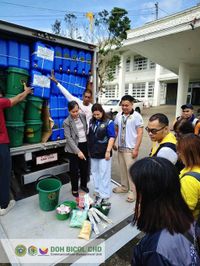On November 9, 2025, as Supertyphoon Uwan—known internationally as Fung-Wong—battered the eastern coast of the Philippines, a seawall meant to protect four coastal villages in Garchitorena, Camarines Sur, gave way, leaving hundreds of residents exposed to the storm’s fury. The collapse of the multimillion-peso structure, built just three years prior, has sparked outrage, fear, and a flurry of calls for accountability from local officials and residents alike.
For many, the seawall was seen as a crucial safeguard against the typhoon-prone Pacific. But as the storm surge breached the barrier, it became painfully clear that the protection was all too fragile. Felipe Mercado, a 70-year-old resident who lost his home, recounted the devastation with disbelief. According to the Philippine Daily Inquirer, Mercado described how the concrete barrier “was torn into pieces like paper,” as he sifted through the debris that once stood between his house and the sea.
The seawall’s failure wasn’t just a personal tragedy—it was a communal one. Hundreds of families in Barangays 1 through 4 were suddenly at risk, their homes and lives exposed to the elements. Another resident, Cesar Valencia, demanded answers, telling the Inquirer, “The lives of the people are more important. There should be an investigation into why the seawall gave way. However, we can clearly see it was [not] properly done since there were no sheet piles and not properly done.” Valencia’s frustration was echoed by many who felt the structure’s collapse was not just a product of nature, but of human error and oversight.
The seawall was originally constructed under a contract awarded on March 23, 2022, by the Department of Public Works and Highways (DPWH) Camarines Sur 4th District Engineering Office. The contract, worth ₱146,986,300.29, was given to Partido Construction and Supply, a firm based in Goa, Camarines Sur. The project was designed to stretch along the coastline from Barangays 1 to 4, with completion scheduled for 2023 to 2024. Official documents obtained by the Inquirer and posted on the Isumbong sa Pangulo page indicated that the contractor was required to submit performance security, construction schedules, safety plans, and other compliance documents before the contract was finalized. Yet, it remains uncertain whether the project underwent a thorough post-construction inspection or audit—a detail now under intense scrutiny.
As the community grappled with the aftermath, local leaders weighed in. Representative Arnie Buquid Fuentebella, speaking in a Facebook Live video, expressed both sadness over the destruction and gratitude for the seawall’s partial success. “If no seawall had been constructed from Barangays 1 to 4, for sure, massive damage might have happened. All I wanted was to protect the residents in the coastal area, and that’s my obligation,” he said. Fuentebella also pointed out that the structure is covered by a five-year warranty, requiring the contractor to reconstruct it—especially since it appeared the seawall lacked crucial sheet piles for stability.
Meanwhile, Camarines Sur Governor Luis Raymund “LRay” Villafuerte Jr. announced that the provincial government would launch an investigation into the collapse. He emphasized the risk posed to hundreds of households during the typhoon and outlined future plans to prevent a repeat of the disaster. “We in the provincial government have a solution to protect the villagers in Garchitorena. We have a green embankment program that would serve as a natural barrier, and we will relocate the residents to a safer place with the help of the national government,” Villafuerte said, as reported by the Inquirer.
The collapse of the seawall wasn’t the only crisis facing the region. As floodwaters inundated communities across Catanduanes, Camarines Sur, Camarines Norte, and Albay, thousands of families were left homeless or displaced. The Department of Health’s (DOH) Bicol Center for Health Development (CHD) quickly mobilized to prevent a secondary public health disaster. Medicines, water purification tablets, water containers, hygiene kits, and breastfeeding kits for pregnant and lactating women were distributed to typhoon victims.
Lea Angela Castillo, from the DOH Bicol CHD Infectious Disease Cluster, explained the urgency of their response during an online talk show, as cited by the Philippine Information Agency (PIA) Bicol: “During emergencies, our sanitation and hygiene services can be compromised. There is no supply of clean water. We do not want to impose a double burden on the people. They have already been affected by the typhoon; we don’t want them to get sick as well.”
DOH Bicol CHD director Rosa Maria Rempillo highlighted the heightened risk of food and water-borne diseases such as diarrhea, cholera, amoebiasis, and typhoid fever in evacuation centers. The agency reported spending over ₱6.5 million to combat these threats, deploying health workers from the Water, Sanitation and Hygiene and Philippine Multisectoral Nutrition Project Response Teams to Catanduanes and other affected areas. The breakdown of assistance was substantial: ₱1,700,000 worth of medicine and health commodities for Catanduanes, ₱3,024,750,000 for Camarines Sur, and ₱1,676,500 for Camarines Norte.
President Ferdinand Marcos Jr. himself visited Catanduanes on November 13, 2025, instructing government agencies to ensure that typhoon victims received the necessary care. The President’s visit underscored the national significance of the disaster and the urgency of a coordinated response.
While immediate relief efforts have helped stave off outbreaks of disease, the underlying issues that led to the seawall’s collapse remain unresolved. Residents are demanding a transparent investigation into the construction and maintenance of the structure, with many pointing to the lack of sheet piles as a critical flaw. The DPWH, the contractor, and local officials now face mounting pressure to explain how a project intended to last decades could fail so quickly and so catastrophically.
For now, the people of Garchitorena and the wider Bicol region are left to pick up the pieces—both literally and figuratively. As they clear debris and rebuild homes, they are also rebuilding trust in the systems meant to protect them. Whether that trust can be restored will depend on the thoroughness of the investigations, the accountability of those involved, and the effectiveness of future protective measures—be they concrete, green embankments, or a combination of both.
In the shadow of Supertyphoon Uwan, the lessons of Garchitorena’s seawall stand as a stark reminder: disaster resilience is as much about integrity and vigilance as it is about engineering and concrete.




